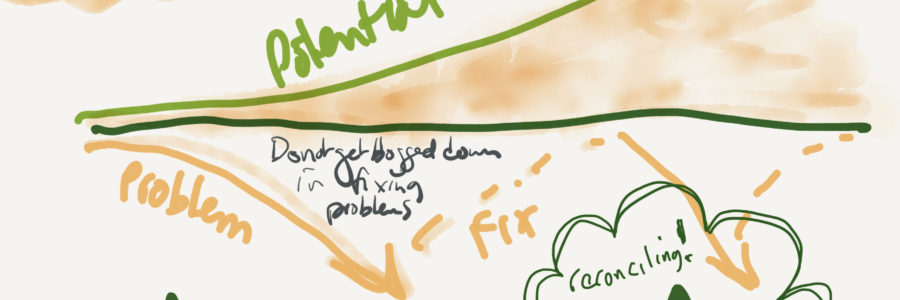
“frozen music”?
Architecture is shelter. It is art and science. It is an enabler. It houses us and our stuff (too much stuff). It is responsible for about a third of the climate emissions we need to curb, worldwide. Architecture is beautiful (but by whose perception?).
One of the most famous answers to the question “What is architecture?” says that architecture is like frozen music.
I have been reflecting on this answer, and I think that it is a definition seriously out of date, a poignant statement that itself is art and thus present to make us think but not necessarily depicting truth.
Let’s recognize that the building is not the point at all.
When I hear “frozen music” I think of stagnancy. Too much architecture has this stagnant moment of perceived beauty due to the lovely photos and renderings with the perfect lighting quality, grown up trees and gardens all properly in bloom, and no pesky wires, fire alarm pull boxes, or errant trash. Or people, unless they are hired models. God, I hate that part most of all.
Give us back the living, functioning, evolving and often messy reality of buildings in real life. Make architectural photography street photography (@erik_smits_ on Instagram) instead of staged, artistic, completely stagnant, 2D compositions. Because I believe we have done the industry serious damage by marketing our sole purpose through depictions of perceived to be perfect single-moment beauty.
First, we have sold the building as an object, allowing users to divorce themselves from how the building works, and how to maintain their own comfort, health, and joy within that structure. There has been research about how pristine plastic, shiny surface, need-no-care buildings are less loved and more likely, as a result, to have a shorter service life.
Second, the profession (yes, I am calling you and me out, architects) has forgotten that we build buildings for people! I mean, yes, we build for them, but we think the building is the point. Let’s recognize that the building not the point at all. It is the function, the living, the building supports that is the point, and that use, that access, must be successful in inspiring the people within to fulfill their own purposes and passions.
Third, we forget that a building needs to exist over time, and time can be a cruel participant. Time is the valued fourth dimension we MUST include. We in the design industry are all so proud of our spacial comprehension, our 3D creatives, but we need to go beyond this to evolving systems that embrace time and become 4D. Even energy modeling, though reflecting time, is a moment in time capture that gets flattened and does not often reflect the intricacies of human interactions with the building, over time.
Lauren Staniec and I had part of this conversation with Bill Reed of Regenesis in an S2C interview. We talked about how his beautiful library in his background on the zoom call was alive because of its history, the changing books, the idea that the shelves needed to be dusted and maybe repaired. It is truly the interactions WITH a space, a building, that create the beauty and value.
The video interview below is quite long, but worthy! (For the mentioned section, click in at 33:52 Participate in Aliveness.)
And yet our magazines and award programs and educational indoctrinations all build upon the images of frozen music, ensuring we are ill prepared for the complex, iterative, process-focused challenges of today and of tomorrow. We need to take what we have (all that lovely and immensely important embodied carbon) and re-vision, re-create to achieve equitable and healthy communities that can evolve and continue to perform well in new ways, and over time. This goes for business, hospitality, education, transportation…no project stands alone, except in pretty pictures.
Another thought: I believe changing our approach away from “frozen music” will help more architects have more work as well as become even more creative.
- The whole pretty-picture, black-cape architecture world is “over there”, expensive, only applicable to the big stuff projects, and inaccessible. But architects, mostly, have the skill of understanding the systemic connections, co-benefits, and co-burdens. We are actually collaborators that can foster and build that capability. We can see the detail while we hold the whole.
- We also have a huge stake in addressing our shared climate crisis and our aligned crisis of equity, economic disparity, and health. I had a professor that said anyone can design when there are no limits. It takes real talent to design when the budget it tight, or space is limited. Amplify our talent and use all the information at hand to be real 4D creatives! Architects make design and material choices every day that impact our climate future directly, and buildings can also foster reconnection of people to natural systems awareness in incredibly impactful ways.
- If we engage in our work on 4D regenerative practice with the owner, community, natural systems, and engaged team, our skills and service will become understood as applying to all of life. We can have positive impact in work from the tiny house to the small school rehab, to city committee work, to a revitalization project for a highway reduction and community connection grant to, yes, even dominant business edifices celebrating a corporation.
For me, architecture is experientially beautiful, a framework for evolution, and certainly 4-dimensional. It has no validity without people, real people, living their lives within the buildings, plazas, and neighborhoods/districts. There is nothing frozen about it, and every moment in architecture should instead be filled with music, the full-spectrum of the sounds of life, over time.
Everything evolves and to ignore that is foolhardy. As architects, engineers, and designers we need to actively engage in and inform the frames that participate in and can support that evolution.
Jodi
